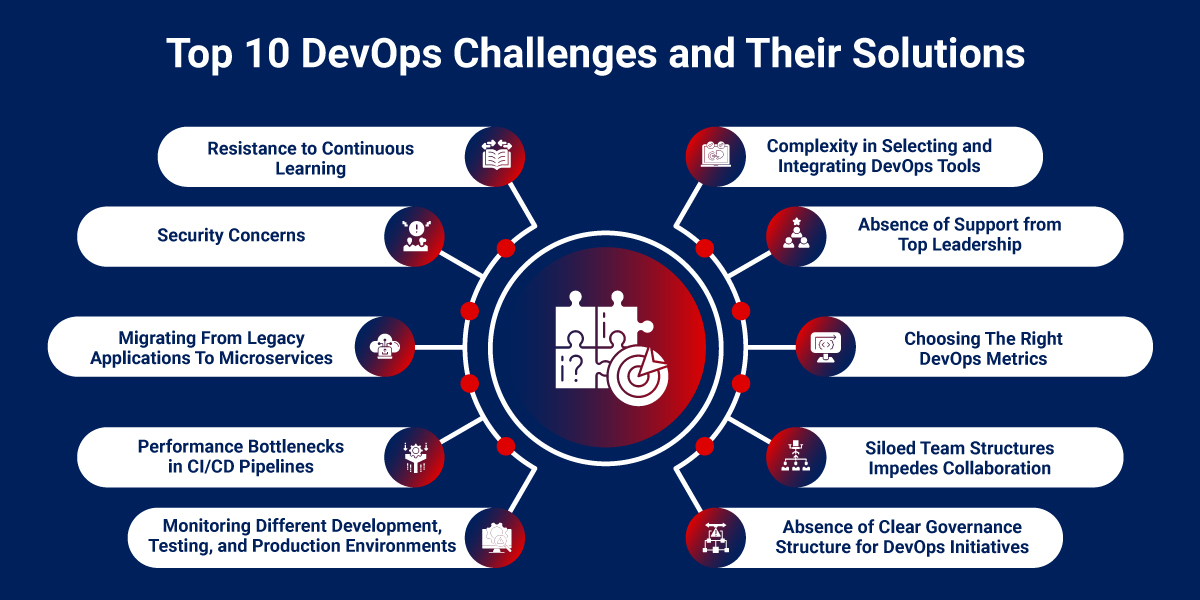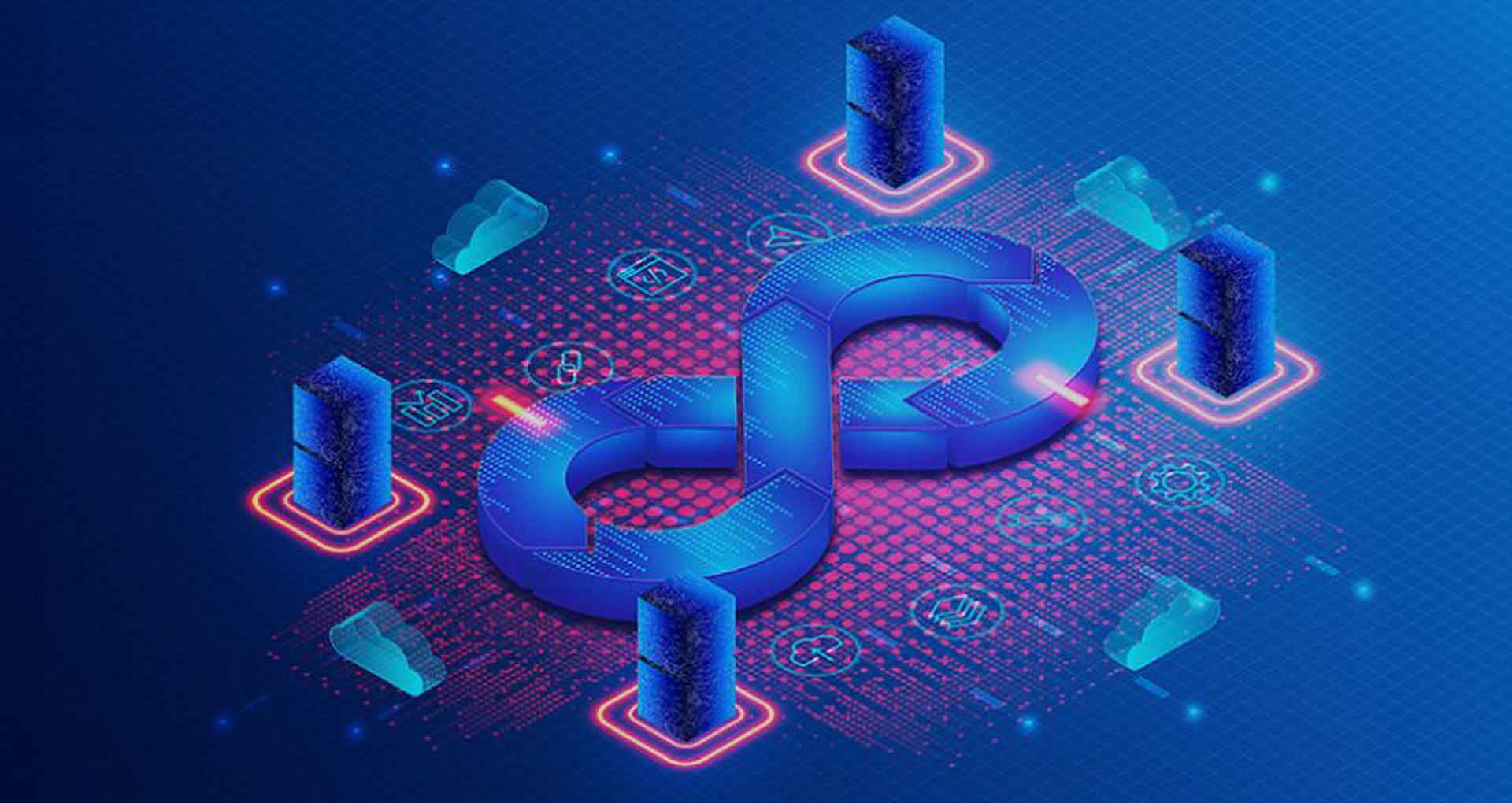DevOps is a cultural and technical approach to improving the overall SDLC workflow. Today, more and more IT organizations realize its benefits as their irregular release cycles get replaced by streamlined continuous integration and continuous delivery pipelines through collaboration and automation.
The advancements in customer-centric service delivery models demand streamlined business processes and improved team culture. DevOps helps automate the processes between development and IT support functions. However, transitioning from the traditional, siloed IT workflows into a collaborative pipeline often offers setbacks and failures. By overcoming common challenges with DevOps adoption and leveraging opportunities, organizations can achieve a competitive edge and grow faster than others.
Let’s explore some common DevOps challenges and solutions to accelerate software delivery and improve your DevOps journey.
10 Common DevOps Challenges and Their Solutions
The path of DevOps implementation includes various roadblocks. Let’s discuss the common DevOps implementation challenges and strategies to overcome them and reap the benefits of faster delivery, improved quality, and greater innovation.

1. Resistance to Continuous Learning
The use of DevOps demands that the working culture within an organization embrace change, especially through the integration of new knowledge. However, some organizations may face resistance from employees who are comfortable with traditional tools and ways of working and may be reluctant to adopt ongoing training and skill development due to time constraint and pressure from workloads.
Solution
You should promote a culture of continuous learning in your organization to stay updated with the latest DevOps trends and updates. Provide learning resources to your team through online or offline courses, workshops, and webinars to enhance their overall skill development and develop a DevOps mindset. This way, your team will be updated on the latest developments in the modern world of DevOps.
2. Security Concerns
The rapid delivery cycle, use of cloud-native technologies, and complex environment introduce new security risks. Traditional security barriers are roadblocks to rapid development and deployment. Integrating robust security practices earlier on into each stage of the DevOps pipeline can be complex and requires a shift in mindset as well as adopting new processes and tools.
Solution
By shifting security left and integrating security right into every stage of the software development lifecycle (SDLC) through DevSecOps, teams can proactively address vulnerabilities, reduce technical debt, and strengthen the overall security posture of their applications. Here are some points to implement:
- Implement rigorous testing and vulnerability scanning as part of the CI/CD pipeline.
- Automate security checks and compliance audits to ensure consistent and reliable security practices.
- Promote a culture of shared responsibility for security by providing training and involving security experts throughout the development process.
3. Migrating From Legacy Applications To Microservices
Since legacy applications are often monolithic with complex dependencies, moving from legacy applications to microservices in a DevOps environment requires careful planning as it increases the complexities of managing many independent service components. Since legacy applications also carry significant technical debts, transitioning from traditional applications to microservices can often be difficult as it requires one to modify the code while ensuring project security and reliability.
Solution
These complexities can be converted into opportunities by focusing on configuration management, automation foundations, and CI/CD. This is essential for managing the increased complexity of microservices architecture.
4. Performance Bottlenecks in CI/CD Pipelines
Manual intervention, especially in the testing and deployment phases of the DevOps process, significantly increases the chances of failure. It impacts the overall developer efficiency and productivity and declines accuracy. The manual process leads to human blunders, which affects the overall SDLC. CI/CD becomes a crucial factor in the software delivery process of organizations; however, it comes with challenges in achieving their optimal performance.
Solution
Companies can tackle these challenges in DevOps by automating the framework and deployment procedures. The use of AIOps can apply machine learning algorithms for root cause analysis and predictive insights.
This will help perform efficient and reliable CI/CD pipeline testing. By automating the manual procedure, organizations can ensure faster feedback loops, more reliable deployments, and a more efficient software delivery process.
5. Monitoring Different Development, Testing, and Production Environments
As the codebase grows and moves through different teams across the software development lifecycle, it encounters inconsistencies in diverse environment configurations. These inconsistencies can make it difficult for the software to perform consistently across multiple platforms and environments. While the team may try to focus and solve the codebase itself, the root cause often lies in the environment, which impacts your team’s productivity, time, and energy. Therefore, ensuring a consistent environment throughout the SDLC is a prominent DevOps implementation challenge.
Solution
Organizations can create infrastructural blueprints for development, testing, and production to ensure identical environments. These blueprints will ensure consistency across environments and identify potential issues. You can also establish clear policies and procedures for environmental management to overcome this DevOps adoption challenge. With these effective practices, organizations can, reduce the risk of environment drift and improve the overall efficiency of their DevOps processes.
6. Complexity in Selecting and Integrating DevOps Tools
Every organization has different requirements, and selecting the ideal DevOps tools is quite challenging in order to execute a successful DevOps strategy. The market includes various tools, from version control systems and automation tools to monitoring and deployment platforms. So, selecting the right toolkit is critical for DevOps success.
Solution
To convert this challenge into an opportunity, organizations can identify the critical metrics and KPIs that align with their DevOps goals. Based on these KPIs, organizations can select and evaluate the right tool. Align the tools with your DevOps objectives, such as improving collaboration, automating processes, or enhancing security.
Once familiar with these essential tools, slowly and gradually introduce additional tools as necessary. To further overcome this DevOps challenge, you must provide comprehensive training to your team to implement these tools proficiently.
7. Absence of Support from Top Leadership
One potential roadblock to a smooth DevOps transition is the lack of proper support from top executive leadership since it demands significant investment in tools, training, and infrastructure. Without full support, it seems challenging to implement any change and achieve the desired business objectives.
Solution
You should educate top-level management on DevOps by providing extensive training and information sessions on DevOps’s principles, practices, and benefits.
- One of the strategic approaches is to share and explain successful case studies and industry examples to provide a clear understanding of the positive impact of DevOps.
- Develop a detailed business case that outlines the potential ROI to explain how DevOps aligns with their strategic business objectives.
8. Choosing The Right DevOps Metrics
As numerous metrics are available, identifying the most relevant and actionable metrics for DevOps practices is complex yet key to successfully transitioning to a DevOps model. It is also important not to focus on a narrow set of metrics or else it can create blind spots. Instead, carefully select metrics that help your organization gain valuable insights into DevOps performance and efficiency.
Solution
- Establish clear, measurable objectives for the DevOps process, such as improving deployment frequency, reducing lead time, or enhancing mean time to recovery.
- Identify the critical metrics that align with the organization’s objectives, such as MTTR, MTBF, MTTD, and mean time to recovery.
- Utilize data visualization tools to present metrics clearly and concisely, making it easier to analyze and understand the data.
- Adjust and refine metrics as and when needed to ensure they remain relevant and actionable.
9. Siloed Team Structures Impedes Collaboration
DevOps requires diverse skills and expertise to collaborate effectively and work together. However, establishing a team with these diverse skill sets might be challenging. Siloed team structures, where different departments or teams work in isolation without effective collaboration, can restrict DevOps practices’ seamless flow of work and success.
Solution
To overcome this challenge in DevOps, organizations should encourage,
- A culture of collaboration and shared responsibility within these teams.
- You should promote forming cross-functional teams composed of members from different departments or functional areas.
- Conduct knowledge-sharing sessions, workshops, and cross-training opportunities to enhance the skills and expertise of team members.
10. Absence of Clear Governance Structure for DevOps Initiatives
DevOps involves rapid changes, continuous integration, and frequent deployments. As a result, software development processes become more complex and involve multiple teams. Without a well-defined governance structure, teams may overlook critical risk factors, compliance and even lead to variations in processes, tools, and quality may arise, affecting overall efficiency. Its absence would create an environment where DevOps initiatives may lack direction, consistency, and accountability.
Solution
- You should define clear governance policies and procedures that outline roles, responsibilities, decision-making processes, and accountability structures for DevOps initiatives.
- Form governance committees comprising key stakeholders from different functional areas to oversee and guide DevOps initiatives, ensuring alignment with organizational goals.
How Can Rishabh Software Help You Achieve Greater Business Agility with DevOps?
At Rishabh Software, we help restructure the traditional server architectures to enhance application performance, data management, and the complete security of your data. We help organizations implement DevOps by supporting them in fostering a culture of collaboration through the use of appropriate tools and practices. Further, we help them overcome common DevOps challenges by improving delivery velocity across microservices, containers, and clouds.
Through our DevOps consulting services, we recommend the best-in-class cloud tools, frameworks, and methods to customers. We are proficient in delivering top quality in the CI/CD implementation pipeline for cloud-based projects. To achieve these goals, we follow a comprehensive DevOps approach.
Rishabh Software’s DevOps Approach
Our DevOps approach emphasizes a continuous integration and delivery (CI/CD) pipeline supported by various tools and frameworks. Key aspects of our DevOps approach include:
- Standardization: Rishabh Software emphasizes standardizing processes, tools, and continuous integration frameworks for efficiency and consistency across the development and deployment lifecycle.
- Quality Assurance (QA) and Testing: QA is integrated throughout the DevOps lifecycle, including acceptance testing. Performance, security, and shift-left testing are prioritized, with unit, and integration tests along with virtualized and cloud test environments. Our team ensures higher-quality software and reliable deployments.
- Strategic Planning: We recognize that tools partnerships and configuration management are key components of the DevOps strategy.
- The CI/CD Pipeline: The continuous integration and delivery (CI/CD) pipeline is at the core of Rishabh’s approach. It covers coding, building, testing, deploying, operating, and monitoring phases, enabling faster software releases.
- Monitoring: Continuous quality monitoring is implemented using tools like Nagios and AppDynamics to ensure that software remains reliable and performs optimally.
- Automation: We adopt automation frameworks and lean principles to streamline processes.
- Tools: We leverage Jira Software, Maven, Confluence, Bamboo, Jenkins, Tricentis, SonarQube, and various monitoring and analytics tools to enhance collaboration and efficiency.
Frequently Asked Questions
Q: What are some common security concerns in DevOps and how can they be addressed?
A: DevOps can introduce security risks due to its fast-paced nature. Here are some common concerns:
- Insecure coding: Code vulnerabilities can create opportunities for attackers.
- Weak access controls: Uncontrolled access to systems and data can be exploited.
- Misconfigured cloud resources: Cloud environments require proper security configurations to avoid breaches.
To address these concerns, consider:
- DevSecOps: Integrate security throughout the development lifecycle.
- Secure coding practices: Train developers on secure coding techniques.
- Vulnerability management: Regularly scan for and patch vulnerabilities.
- Access controls: Implement strong access management policies.
Q: What problems does DevOps solve?
A: DevOps tackles several issues that arise when development and operations teams are isolated. Here are some key areas it improves:
- Slow and error-prone deployments: DevOps promotes automation, streamlining deployments and reducing errors.
- Communication silos: It fosters collaboration between Dev and Ops, breaking down communication barriers.
- Infrastructure management challenges: DevOps helps manage and scale infrastructure more effectively.
- Limited visibility into application performance: DevOps provides better visibility into application performance.











 30 Min
30 Min


